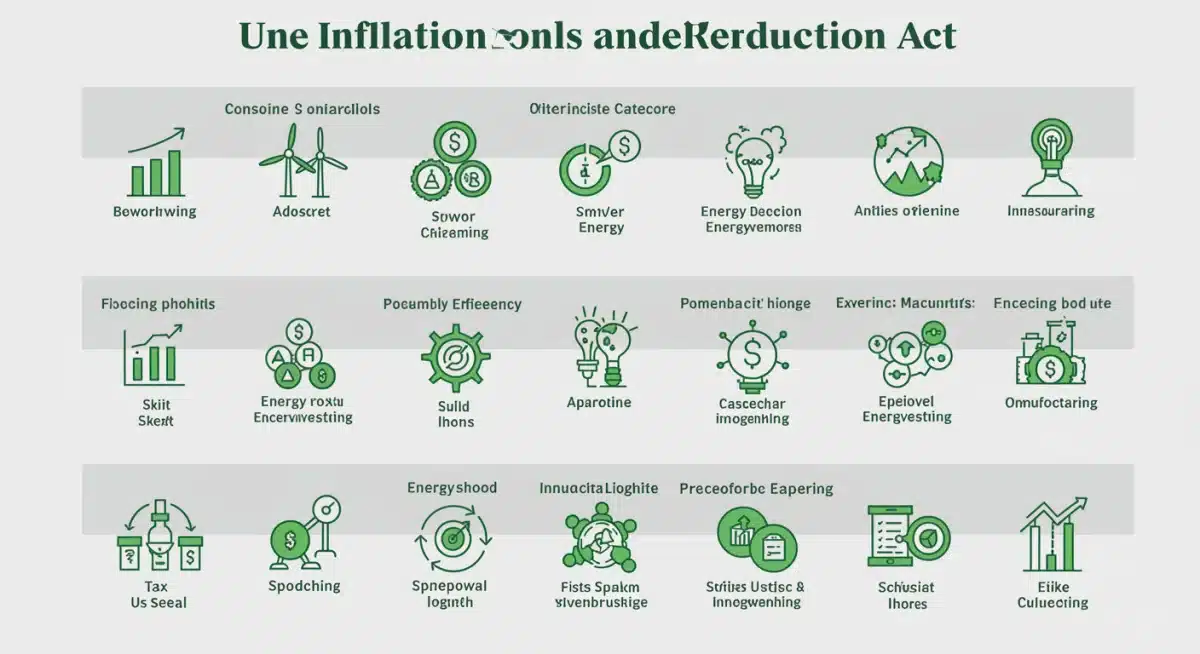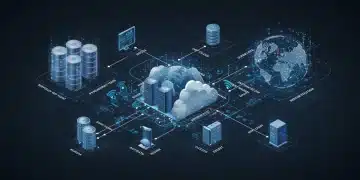IRA 2025 Tax Credit Updates: Small Business Impact

The Inflation Reduction Act’s 2025 tax credit updates present significant financial implications for small businesses, offering new incentives and requiring strategic planning to optimize their bottom line and ensure compliance.
Breaking news for entrepreneurs: The Inflation Reduction Act’s 2025 Tax Credit Updates: What They Mean for Your Small Business’s Bottom Line is set to reshape financial strategies across the nation. As of today, new details emerge, pointing to both opportunities and critical considerations for small and medium-sized enterprises. What exactly do these changes entail for your company’s future?
Understanding the Inflation Reduction Act’s Core Changes for 2025
The Inflation Reduction Act (IRA), signed into law in August 2022, represents a landmark piece of legislation designed to combat inflation, invest in domestic energy production and manufacturing, and reduce carbon emissions. For small businesses, the act introduced a myriad of tax credits and incentives aimed at encouraging investments in clean energy, energy efficiency, and sustainable practices. As 2025 approaches, several key provisions are undergoing updates, adjustments, or full implementation, directly impacting how businesses can leverage these benefits.
These changes are not merely administrative; they reflect ongoing efforts by the Treasury Department and the IRS to refine the act’s mechanisms, address initial implementation challenges, and ensure the credits achieve their intended goals. Small businesses must remain vigilant, as specific eligibility criteria, credit amounts, and application processes are subject to modification. Understanding these foundational shifts is paramount for strategic financial planning and maximizing potential savings in the coming fiscal year.
Key Updates to Clean Energy Credits
Several clean energy tax credits, central to the IRA, are seeing significant updates for 2025. These adjustments are designed to streamline access and enhance the attractiveness of renewable energy investments for a broader range of businesses, including those without substantial tax liabilities.
- Increased Direct Pay Option: The direct pay option, allowing tax-exempt entities and certain government entities to receive cash payments for elective credits, is being expanded and clarified for small businesses. This is a game-changer for many, as it effectively monetizes credits even if a business lacks sufficient tax liability to utilize them otherwise.
- Energy Efficiency Enhancements: Credits for energy-efficient commercial buildings (179D) and residential clean energy improvements are being fine-tuned. The thresholds for energy savings are under review, potentially offering more accessible benchmarks for small businesses undertaking upgrades to their facilities.
- Domestic Content Requirements: The IRS has issued further guidance on domestic content requirements for certain clean energy projects to qualify for bonus credits. Small businesses engaging in manufacturing or sourcing components domestically will find these clarifications crucial for maximizing their credit value.
Navigating the New Landscape of Manufacturing and Investment Incentives
Beyond clean energy, the IRA also introduced substantial incentives for domestic manufacturing and investment, particularly in critical minerals and clean technology components. For 2025, the focus intensifies on ensuring these incentives translate into tangible economic growth and job creation within the U.S. Small businesses involved in supply chains for these sectors stand to benefit significantly, provided they meet the evolving criteria.
The Treasury Department is actively working to provide clearer definitions and guidance on what constitutes eligible manufacturing processes and how to accurately calculate the credit amounts. This clarity is essential for small businesses that might be hesitant to invest without a firm understanding of the financial returns. Early indications suggest a push towards simplifying the application and substantiation process to encourage broader participation.
Advanced Manufacturing Production Credit (45X) Details
The Advanced Manufacturing Production Credit (45X) is a cornerstone of the IRA’s industrial policy, offering credits for the domestic production of certain solar and wind components, inverters, and critical minerals. For 2025, the IRS is expected to finalize rules around production calculations and eligibility.
- Production Volume Verification: New guidelines are anticipated to clarify how production volumes will be verified, crucial for small manufacturers looking to claim the credit accurately.
- Component Definition Refinements: The definitions of eligible components are being refined to prevent ambiguity and ensure the credits are directed to the intended segments of the supply chain.
- Transferability Provisions: Further guidance on the transferability of these credits to unrelated third parties is also expected, offering flexibility for businesses to monetize their credits.

Specific Tax Credits Impacting Small Business Operations
The IRA’s broad scope means that various tax credits can directly influence the operational costs and investment decisions of small businesses. From electric vehicle purchases to sustainable farming practices, the 2025 updates aim to make these incentives more accessible and impactful. Recent announcements from the IRS highlight a commitment to reducing administrative burdens where possible, while also ensuring compliance and preventing abuse.
Small business owners are urged to consult with tax professionals specializing in the IRA to identify all applicable credits. The complexity of the act means that a tailored approach is often necessary to fully capitalize on the available benefits. Ignoring these updates could mean missing out on substantial financial advantages that could propel growth and enhance competitiveness.
Commercial Clean Vehicle Credit (45W) Adjustments
The Commercial Clean Vehicle Credit (45W) provides a significant incentive for businesses to transition their fleets to electric or clean-fuel vehicles. For 2025, several adjustments are in play to broaden eligibility and simplify the credit calculation.
- Vehicle Type Expansion: The list of eligible vehicle types is under review, potentially including more specialized commercial vehicles relevant to small businesses.
- Purchase vs. Lease Clarifications: The IRS is expected to provide clearer guidance on how the credit applies to leased vehicles versus outright purchases, a common financing method for small businesses.
- Credit Cap Revisions: While the credit remains substantial, there might be minor adjustments to the per-vehicle credit caps to align with market developments and vehicle costs.
Strategic Planning: Maximizing Benefits and Ensuring Compliance
For small businesses, the 2025 updates to the IRA tax credits necessitate a proactive and strategic planning approach. Simply being aware of the credits is not enough; businesses must actively integrate these opportunities into their financial forecasts and operational decisions. This involves more than just identifying eligible expenses; it requires a deep dive into compliance requirements, record-keeping best practices, and potential interactions with other federal or state incentives.
The IRS has indicated increased scrutiny on claims related to the IRA credits, underscoring the importance of meticulous documentation and accurate reporting. Businesses that fail to meet compliance standards risk penalties, delays, or even disallowance of credits. Therefore, robust internal processes and expert guidance are not optional but essential for navigating this complex landscape successfully.
Best Practices for Credit Utilization
To maximize benefits and ensure compliance, small businesses should adopt several key best practices.
- Early Assessment: Conduct an early assessment of potential eligibility for all relevant credits based on planned investments and operational changes for 2025.
- Detailed Record-Keeping: Maintain comprehensive records for all expenditures and activities related to claimed credits, including invoices, contracts, and certifications.
- Professional Consultation: Engage with tax advisors and legal counsel experienced in IRA provisions to interpret complex guidance and ensure accurate filings.
- Stay Informed: Regularly monitor IRS and Treasury Department announcements for new guidance, FAQs, and rule changes that could impact eligibility or credit amounts.
Impact on Small Business Investment and Growth
The IRA 2025 Tax Credits updates are poised to significantly influence investment decisions and growth trajectories for small businesses across various sectors. By providing financial incentives for sustainable practices, clean energy adoption, and domestic manufacturing, the act aims to stimulate economic activity and foster innovation. Small businesses that strategically leverage these credits can reduce their operating costs, invest in modern technologies, and enhance their competitive edge in the market.
For many small businesses, the availability of these credits can de-risk new investments in areas like renewable energy installations or energy-efficient equipment, which might otherwise be prohibitively expensive. This translates into tangible growth opportunities, from expanding production capabilities to entering new markets. The long-term vision of the IRA is to create a more resilient and sustainable economy, with small businesses playing a vital role in achieving these objectives.
Long-Term Economic Implications
The long-term economic implications for small businesses are substantial. Beyond immediate tax savings, these credits can foster a culture of sustainability and innovation.
- Enhanced Competitiveness: Businesses investing in clean technologies may gain a competitive advantage through lower energy costs and a positive public image.
- Job Creation: Increased domestic manufacturing and clean energy projects are expected to drive job creation within small and medium-sized enterprises.
- Supply Chain Resilience: Incentives for domestic content can strengthen local supply chains, reducing reliance on foreign markets and enhancing economic stability.
Resources and Support for Small Business Owners
Recognizing the complexity of the Inflation Reduction Act, various resources and support channels are available to help small business owners navigate the 2025 tax credit updates. The IRS has committed to providing clearer, more accessible guidance, including updated FAQs, webinars, and dedicated helplines. Additionally, numerous non-profit organizations, industry associations, and government agencies offer assistance tailored to the needs of small businesses.
Leveraging these resources is crucial for demystifying the IRA and ensuring that businesses can effectively claim the credits they are entitled to. Proactive engagement with these support systems can save time, reduce potential errors, and provide peace of mind in an evolving regulatory environment. The goal is to empower small businesses to harness the full potential of these transformative incentives.
Key Support Channels
Small businesses should utilize these channels for up-to-date information and assistance.
- IRS.gov: The official IRS website is the primary source for all tax-related guidance, forms, and FAQs concerning the IRA.
- Small Business Administration (SBA): The SBA provides resources, workshops, and counseling services to help small businesses understand and access federal programs, including tax incentives.
- Industry Associations: Many industry-specific associations offer specialized guidance and advocacy related to the IRA’s impact on their members.
- Tax Professionals: Certified public accountants (CPAs) and tax attorneys with expertise in clean energy and manufacturing credits can provide invaluable personalized advice.
| Key Aspect | Brief Description |
|---|---|
| Clean Energy Credits | Expanded direct pay options and refined eligibility for solar, wind, and energy efficiency projects. |
| Manufacturing Incentives | Clarified rules for advanced manufacturing production (45X) to boost domestic supply chains. |
| Commercial Vehicle Credits | Adjustments to the 45W credit for electric vehicles, broadening eligibility for business fleets. |
| Strategic Planning | Essential for maximizing benefits, ensuring compliance, and leveraging resources effectively. |
Frequently Asked Questions About IRA 2025 Tax Credits
The primary goal is to encourage small businesses to invest in clean energy, energy efficiency, and domestic manufacturing. Updates aim to clarify eligibility, simplify access, and ensure compliance, ultimately boosting the bottom line while promoting sustainable economic growth across the U.S.
The direct pay option allows eligible small businesses, even those without sufficient tax liability to offset credits, to receive a direct cash payment from the IRS. This effectively monetizes the tax credits, making clean energy investments more financially viable and accessible for a wider range of companies.
Industries heavily involved in renewable energy, energy-efficient building construction or upgrades, electric vehicle manufacturing and adoption, and domestic production of critical components are expected to see the most significant impacts. However, many businesses can find relevant credits.
Small businesses should proactively assess their eligibility, maintain meticulous records of relevant expenditures, consult with tax professionals specializing in IRA provisions, and continuously monitor official IRS and Treasury guidance for the latest updates and clarifications to ensure compliance.
The IRS is issuing further guidance to refine and clarify domestic content requirements, rather than necessarily making them stricter. The aim is to ensure the credits effectively incentivize U.S. manufacturing and sourcing, providing clearer benchmarks for businesses to meet and maximize their credit value.
What Happens Next
As 2025 draws closer, small businesses must remain acutely aware of the ongoing developments surrounding the Inflation Reduction Act’s tax credit updates. The Treasury Department and the IRS are expected to release additional guidance and clarifications, particularly regarding specific credit calculations and compliance protocols. Businesses should anticipate a dynamic regulatory environment, necessitating continuous monitoring and adaptive financial strategies. The long-term success of these incentives hinges on their effective utilization by the small business sector, driving both economic growth and sustainable practices nationwide.





